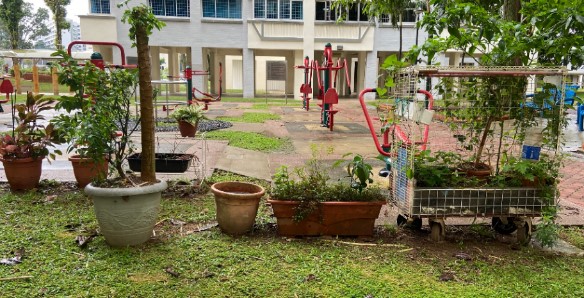Quality Interactions in the Garden • Bumble Bee Child Care Centre

|
Learning Areas |
Learning Goals Children will: |
|
Discovery of the World (DOW) |
LG 1: Show an interest in the world they live in LG 2: Find out why things happen and how things work through simple investigations |
|
Language and Literacy (L&L) |
LG 2: Speak to convey meaning and communicate with others |
Learning Objectives
- Use their senses to explore the natural environment during their visit to the community garden.
- Observe the natural environment and ask questions, seek answers to their questions and respond through sustained conversations with the teachers and peers.
Before visiting the garden: Tapping the children’s prior knowledge
How?
- The teacher and children brought pictures of plants and flowers they had at home.
- The teacher brought dried leaves, fresh leaves, twigs, and branches for the children to explore using their senses within their classrooms.
- The teacher then provided the children the space and time to share their own experiences in interacting with plants and flowers in the neighbourhood gardens, parks, or nature reserves with each other. The teacher used a KWL chart to record and organise the children’s thoughts and questions
The visit to the garden
- Environment: The community garden offered a rich source of stimuli for the children, where they could use their senses to observe, feel and explore the various plants and gardening items.
- Teacher: The teacher engaged in sustained conversations with the children by asking relevant questions to stimulate their thinking further. Tapping their sense of wonder and curiosity, the following questions were used to prompt children’s thinking:
- What do you see/hear/feel/smell?
- How are the leaves alike/different?
- What are the parts of the plant you see here?
- How do you think the plants grew so tall?
- Can you see any insects?
- What made the insects live here?
- What do you think is going to happen if there is no rain?
- Peers: Children observed the things around the community garden, asked questions and engaged in conversations with their peers about their observations
|
Co-constructing knowledge
about papaya plants Child A: Look, there is a
papaya up in the tree! Child B: Is it a coconut? Child C: Coconuts are not oval,
so I think it’s a papaya. This papaya cannot eat yet, must wait until it
becomes orange in colour. |
|
Using open-ended questions
and providing additional information to expand children’s understanding
Child A: Why is there a
bottle stuck in the soil? Teacher: How do you think
the bottle got into the soil in the planter? Child B: The gardener put
it there, but why? (Children asked questions
and discussed among themselves, but they could not reach a consensus. The
teacher stepped in to facilitate children’s learning by promoting the
children and provided additional information to help develop children’s
understanding.) Teacher: Can you see that
the pot is very big? If you were to pour water, do you think the water can go
down all the way to the roots? What do you think would happen if the roots do
not have enough water? Children: The plant will
die. Teacher: The gardener cut
the base of the bottle off and stuck it into the soil. This helps the water
reach the roots at the bottom if you water it through the bottle. |
After the visit to the garden
- The children had an opportunity to plant their own green bean plant.
- The children recorded their plant’s growth at different stages through drawings and emergent writing
